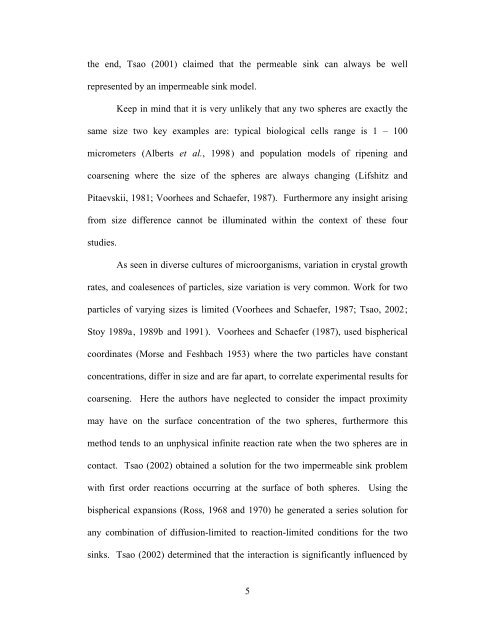Diffusion Reaction Interaction for a Pair of Spheres - ETD ...
Diffusion Reaction Interaction for a Pair of Spheres - ETD ...
Diffusion Reaction Interaction for a Pair of Spheres - ETD ...
Create successful ePaper yourself
Turn your PDF publications into a flip-book with our unique Google optimized e-Paper software.
the end, Tsao (2001) claimed that the permeable sink can always be well<br />
represented by an impermeable sink model.<br />
Keep in mind that it is very unlikely that any two spheres are exactly the<br />
same size two key examples are: typical biological cells range is 1 – 100<br />
micrometers (Alberts et al., 1998) and population models <strong>of</strong> ripening and<br />
coarsening where the size <strong>of</strong> the spheres are always changing (Lifshitz and<br />
Pitaevskii, 1981; Voorhees and Schaefer, 1987). Furthermore any insight arising<br />
from size difference cannot be illuminated within the context <strong>of</strong> these four<br />
studies.<br />
As seen in diverse cultures <strong>of</strong> microorganisms, variation in crystal growth<br />
rates, and coalesences <strong>of</strong> particles, size variation is very common. Work <strong>for</strong> two<br />
particles <strong>of</strong> varying sizes is limited (Voorhees and Schaefer, 1987; Tsao, 2002;<br />
Stoy 1989a, 1989b and 1991). Voorhees and Schaefer (1987), used bispherical<br />
coordinates (Morse and Feshbach 1953) where the two particles have constant<br />
concentrations, differ in size and are far apart, to correlate experimental results <strong>for</strong><br />
coarsening. Here the authors have neglected to consider the impact proximity<br />
may have on the surface concentration <strong>of</strong> the two spheres, furthermore this<br />
method tends to an unphysical infinite reaction rate when the two spheres are in<br />
contact. Tsao (2002) obtained a solution <strong>for</strong> the two impermeable sink problem<br />
with first order reactions occurring at the surface <strong>of</strong> both spheres. Using the<br />
bispherical expansions (Ross, 1968 and 1970) he generated a series solution <strong>for</strong><br />
any combination <strong>of</strong> diffusion-limited to reaction-limited conditions <strong>for</strong> the two<br />
sinks. Tsao (2002) determined that the interaction is significantly influenced by<br />
5
















